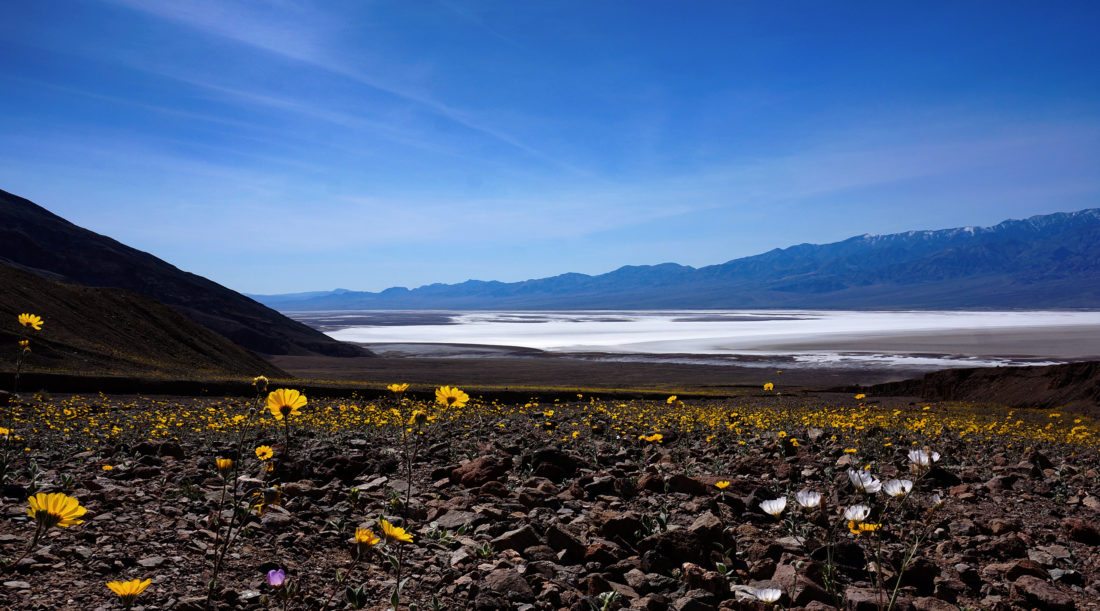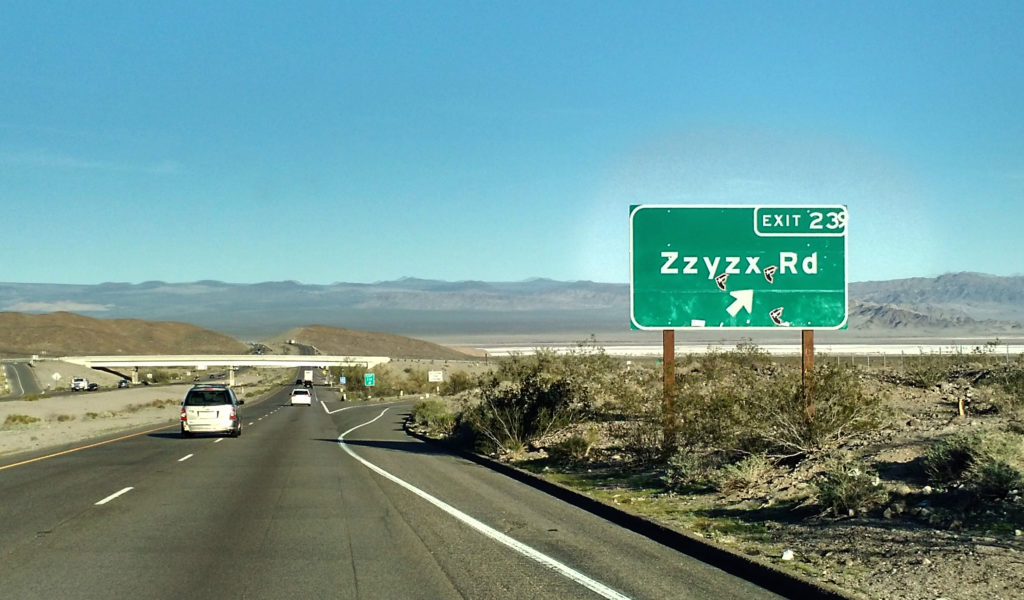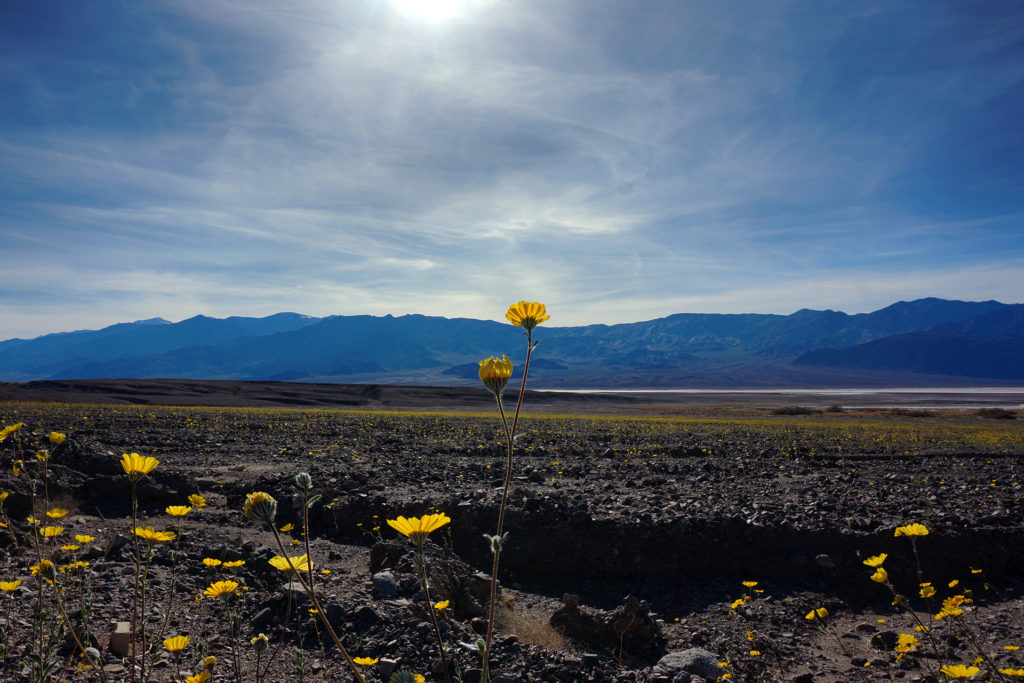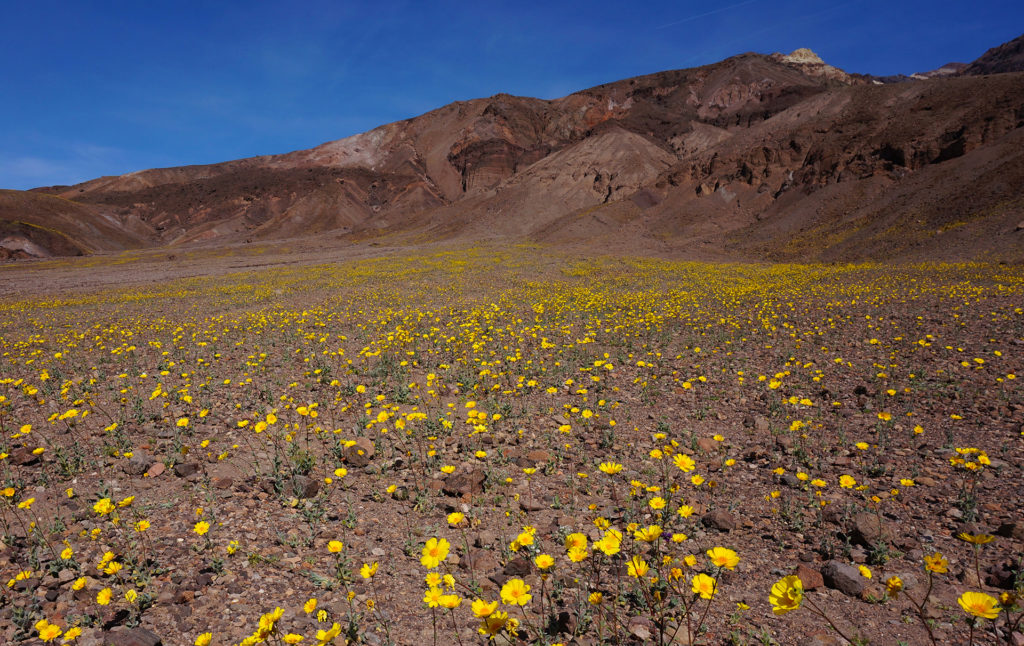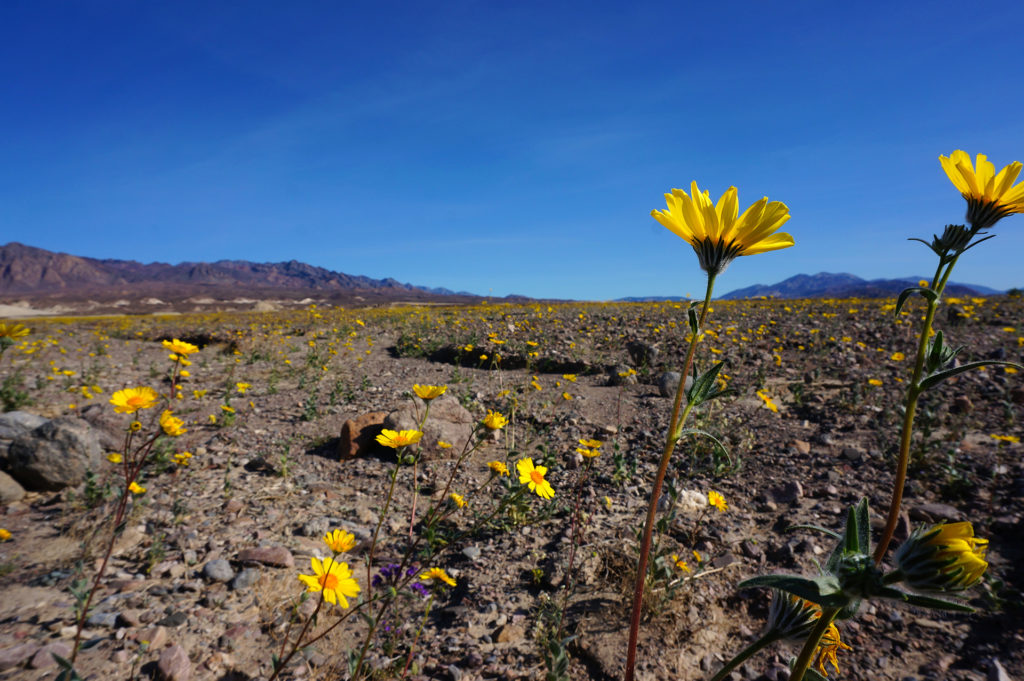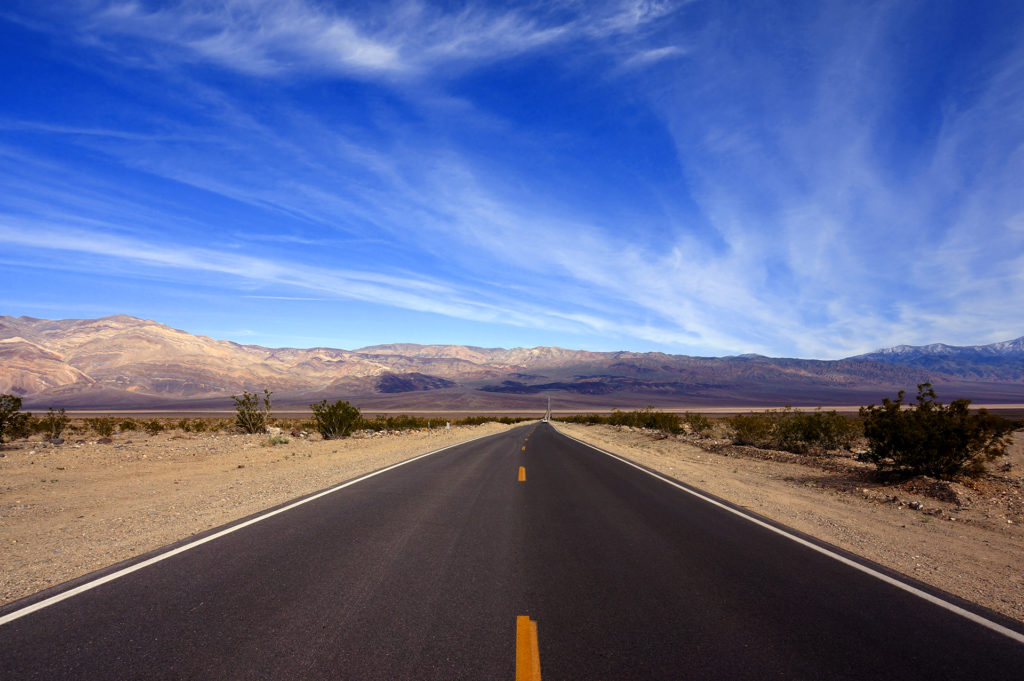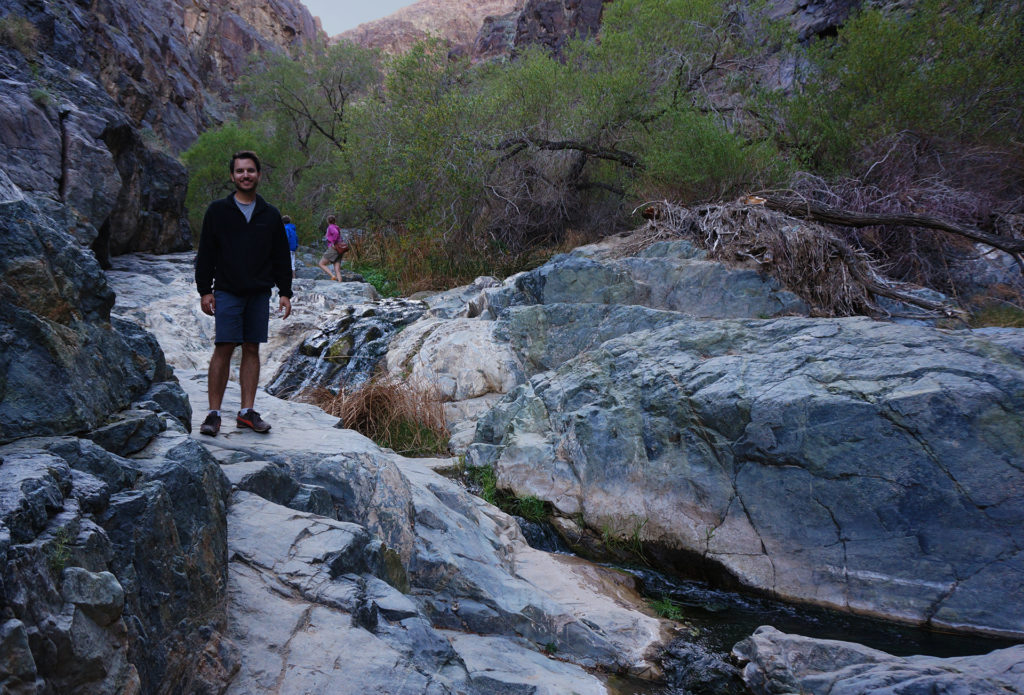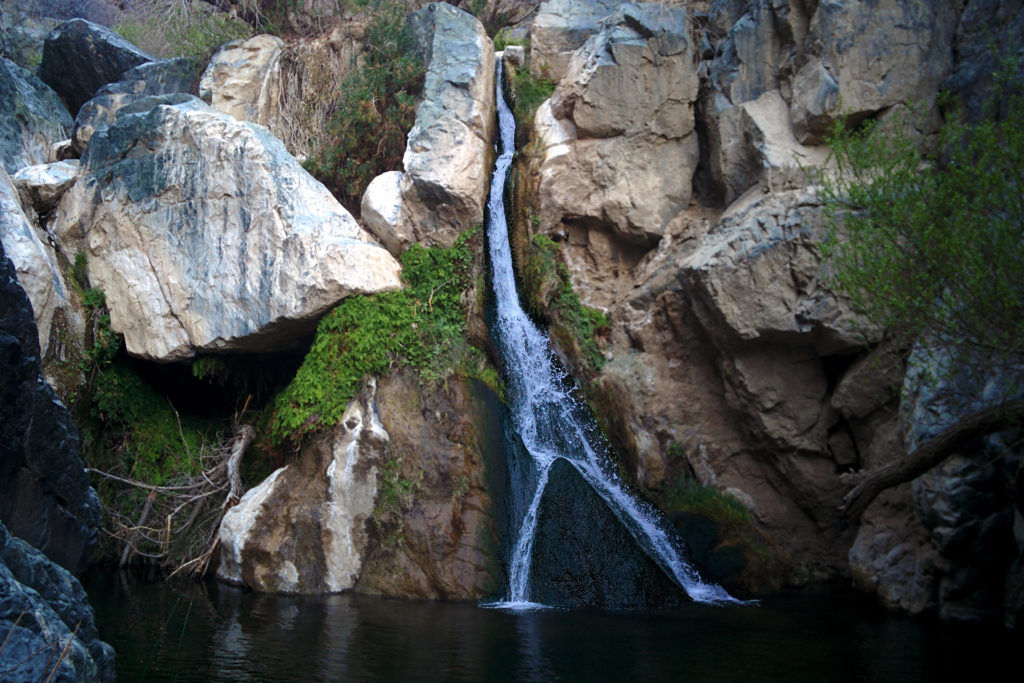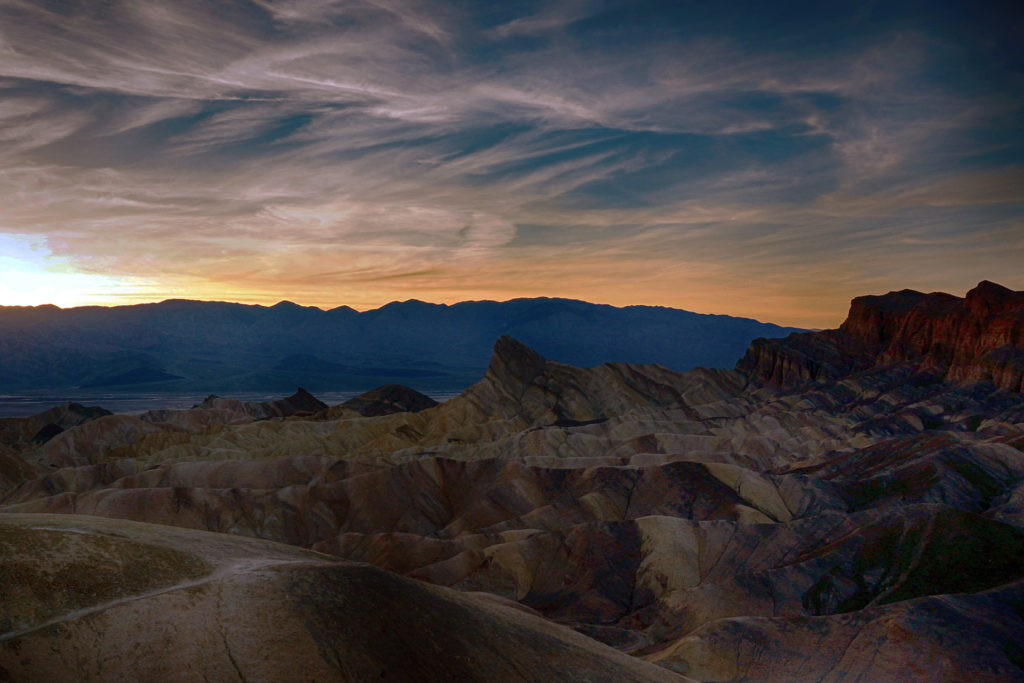Week 35: Death Valley Is Incredible
People often ask us what our favorite place has been so far on our trip. Well, there have been quite a few. We covered one of the places in our last blog post: San Diego, “the land of perfect weather and also lots of beer.” As luck would have it, our next stop also turned out to be one of our favorites: Death Valley, “the land of perfect February weather and also has some beer.”
Whoopsie Goldberg
It’s a long 362 miles from San Diego to Death Valley, and we unfortunately had a bit of a rough start. About 20 miles out of San Diego, we stopped to get gas in a suburban gas station that looked like it would be big on the GasBuddy map. Unfortunately, the station turned out to be very small. Stubbornly, we tried to drive into the station anyway, but we ran into some problems.
Well, more accurately, we ran into a cement pole.
It was really just a scrape along the side of the RV, but we got a little stuck. A little-known fact is that an RV pulling a car towed “flat” (i.e., not in a dolly) cannot back up without causing serious damage to the car. As you probably guessed, that is how we pull our car, so it took a little while – and some frantic unhooking – to get things sorted away. In the end, it wasn’t so bad: the RV was basically fine, minus an inconsequential dent and some paint, and the cement pole didn’t even seem bothered.
Our takeaway from this misadventure? Never leave San Diego.
Drive into Death
After feeling like novice RV drivers, we shook off our little blunder, and marched on to Death Valley. The drive took us back past Los Angeles, up and over a fairly serious mountain pass, and then into a long descent into a broad plain. The population began thinning out, and we passed Barstow, then Baker (home to a giant thermometer – don’t visit in the summer), and the road to the Scrabblicious town of Zzyzx.
We turned off the interstate, and towards Death Valley… another 120 miles away. It was dark by the time we made it to our campsite, basically a painted rectangle in a big dirt parking lot. We definitely annoyed our star-gazing neighbors with our headlights as we tried to back into the spot in the dark.
We couldn’t see anything outside except for a different neighbor, who was watching a black and white movie outside, on a big-screen TV, using a fairly loud generator. (We declined his invitation to join.) So, we went to bed, and the next morning, we awoke to a pretty magical place.
Welcome to Death Valley
The first thing you should know about Death Valley is that it’s a National Park, which means that it’s awesome, and the second thing is that it is huge. More than 5,200 square miles – roughly the size of Jake’s home state, Connecticut. It is in California, which is the size of 32 Connecticuts, and it’s tucked away in the eastern part, near Nevada. There isn’t a whole lot around.
Now, just about everyone has heard of Death Valley, and they probably know it is dry, hot, and low. All of those things are true – much of Death Valley is dry and hot, and the low parts are very low: at 282 feet below sea level, it is the sixth-lowest place on Earth (just ahead of the smelly Salton Sea). But most people (like past Jake and Heather) do not know that Death Valley is also full of stunning mountain ranges, beautiful rock formations, and towering sand dunes.
If you go hiking up in the mountains, you’ll find some very unexpected things, like a waterfall. And if you are lucky enough, and visit during just the right February, you will be treated to something spectacular: a once-in-a-decade wildflower superbloom.
Death Valley National Park is a totally unique, beautiful, and surreal world, the ultimate desert. The mountains and rocks here are not gray and featureless, but vibrantly colorful. There are salt flats, shimmering white, covered with undulating patterns. There are sand dunes, canyons, and arches, and the stars shine brighter in Death Valley than almost anywhere on Earth. And when we were there, it was carpeted with wildflowers.
Flower Power
Death Valley experienced a wildflower “superbloom” this Spring, basically because it rained last October. We understand it is normally bare, but when we were there, the flowers were growing everywhere throughout the park. Vast fields of yellow flowers covered the rock, flecked with white and purple flourishes like paint from a flicked brush.
The flowers were a constant companion in our exploration of Death Valley. Unlike most places you see flowers, these grow on what otherwise looks like bare rock, so there’s nothing green behind it. The effect is totally unique, seemingly flaunting the impossibility of what nature has produced.
Like everyone else at Death Valley, we also took their picture! A lot. It wasn’t unusual to see people pulled over on the side of the road, wandering into the wildflower meadows with their cameras. We did it too, and we have to say – frolicking through a wildflower meadow was definitely not what we imagined when we decided to visit Death Valley.
We Went Down, Down, Down
There was a lot to see in Death Valley, so we’re going to start at the bottom and work our way up. The most famous part of Death Valley is the salt flats, specifically the area named Badwater Basin (named for a small pond you definitely don’t want to drink from). As we mentioned, it sits at -282 feet below sea level, making it one of the lowest places on Earth.
The salt flats are the result of thousands of years of flash floods, which wash salt and other minerals off the nearby peaks and into the low-lying valley before evaporating. The salt forms into an array of geometrical patterns, endlessly shifting with the wind. Although the temperature was comfortable, the sun was blazing; if we had visited in the summer, it would have been brutally hot.
An amazing fact about Badwater Basin is that it runs along a mountain range, or really, is part of it – imagine a flat plane, like a piece of plywood, that has been flipped up nearly vertically. The result is that the peaks just a few miles away rise to more than 11,000 feet. Seeing something that high from one of the lowest places on earth is surreal.
After Badwater Basin, and some more wildflower frolicking, we came to the awesomely-named Devil’s Golf Course. Speaking of an endless array of geometrical patterns, the shapes formed here are truly fascinating. However, the little salt and rock spires are sharp, and extremely coarse – signs warn you very strongly not to fall over onto them.
But we went out and took a few pictures anyway, because #YOLO.
Canyonero
The geology of Death Valley is extremely varied, and goes far beyond murderous salt flats. One of our favorite features was the numerous slot canyons. We walked through the Golden Canyon, which twisted and turned before opening into a much larger canyon. We met a woman here on crutches – she had apparently just broken her foot, but decided to go through with her vacation anyway. Hardcore!
We also drove up to Mosaic Canyon, which is about 1.5 extremely bumpy dirt-road miles off the main drag. It featured incredibly smooth marble walls that were glorious to touch, as well as coarse, aggregate walls studded with millions of tiny rocks (the “mosaic”). Extremely cool.
We also walked through the canyon at Natural Bridge, which unsurprisingly features a… natural bridge (arch). The views of the salt flats from here, seen over a verdant field of wildflowers, was simply stunning.
Painting With Minerals
Death Valley, like the Petrified Forest, offers lots of vibrantly colorful badlands. We drove the park’s popular loop road, the beautiful Artists’ Drive, and gawked at the scenery the entire way. The crown jewel is called Artists’ Palette, a rock formation that looks as though each face was painted a different hue. We don’t really know how this happens, but we suspect the culprits were highly aesthetic witches.
Nearby, but on the other side of the mountain range, was Zabriskie Point. This spot is known for its beautiful sunsets, and we saw a good one, albeit not as mind-blowing as it can apparently become. Frankly, it didn’t matter – the infinitely varied badlands and the views of the valley are pretty under any kind of light.
Sand Dunes and Star Wars
One of the most famous features of Death Valley are the Mesquite Sand Dunes, which appear in lots of movies, including the first two (original) Star Wars. Actually, lots of Star Wars scenes were filmed in Death Valley, as this fascinating guide shows. In any event, we love us some sand dunes, since they are great for photographing.
With all the other things to do, we didn’t spend as much time here as at White Sands National Monument, but we did find time to recreate our Nothing Mundane mark
High Desert
Alright, enough of this low desert stuff. We spent an entire day driving west from our campground (reminder: Death Valley is huge) to explore the numerous mountain ranges in Panamint Springs. We went up and over a high pass, down into a low valley, and up and over another pass. Whew!
We’re definitely glad we did all this, because this was one of the most unique drives we’ve ever taken. The horizon is so flat we often couldn’t even tell we were going uphill! At one point, we thought our car was having mechanical problems because the RPMs were so high. However, we realized when we drove back the same way that we had just been going up a massive grade – totally unaware of it.
At every point along the way, the mountains and the views were magnificent. The highway hugs the cliffs while spiraling around the peaks – definitely not the kind of place you want to speed (although, of course, lots of people did). Also not a good place to have your brakes fail… and ours did not, so thanks, fly-by-night mechanic from New Jersey!
In between two mountain peaks, we entered a crazy valley, traversed by a steep but perfectly-straight road. The flats here, different from Badwater Basin, offered their own grand views. And since it’s 2016, beyond the normal selfies, there were people modeling here for a photoshoot. In the absolute middle of nowhere. We live in strange times.
Liquid Treasures
On the way back from our trip over the mountains, we stopped at a magical little place called Darwin Falls. It was a bumpy 4-ish mile dirt road ride – calling to mind Big Bend – which is not uncommon for Death Valley sights. We later found out you can rent a Jeep right by our campsite. We drove past the rental place in the dark and had no idea!
We then hiked out to the falls, about two miles away. We weren’t sure what to expect, or even if we were in the right place, but we were heartened by a conspicuous – and leaky – water pipe running along the trail. Slowly, the canyon narrowed, and the vegetation grew thicker.
It was practically a jungle by the time we turned a corner, hopped across a stream, and ducked around a tree. There, before us in a grotto, was Darwin Falls, the hidden jewel in the heart of Death Valley. Few things we have seen before or since were so magnificently unlikely.
We headed back to our RV on a cloud. We stopped near the sand dunes at the Stovepipe Wells general store to get a sticker (yep, there are stores in Death Valley), and were greeted with something else magnificently unlikely: a huge and refrigerated wall of drinks, including craft beers. We got a six pack of Stone Ruination for less than we used to pay in Manhattan! Inside Death Valley!!
It is a land of surprises.
Visiting Death Valley
Death Valley National Park is amazing, and you should go. It’s not the easiest place in the world to get to, but you can get there in a few hours from Las Vegas. If you’re interested, you’ll need to go in roughly November-March, and you’ll probably need an RV, unless you like camping on hard earth or can snag one of the few cabins. (Because of the RV requirement, the visitors are actually almost entirely retirees, which is unusual for a national park.)
It’s magical and cool, and there’s so much we didn’t even get to see, like Scotty’s Castle (currently closed due to flood damage), or the incredible sailing stones – featured on Planet Earth – which require a 4WD vehicle to access.
If you can, try to time it up to a superbloom. The next one should be in about 11 years. We’ll meet you there.
Previous Post: Weeks 33-34: Swooning Over San Diego
Next Post: Week 36: Vegas, Baby!

